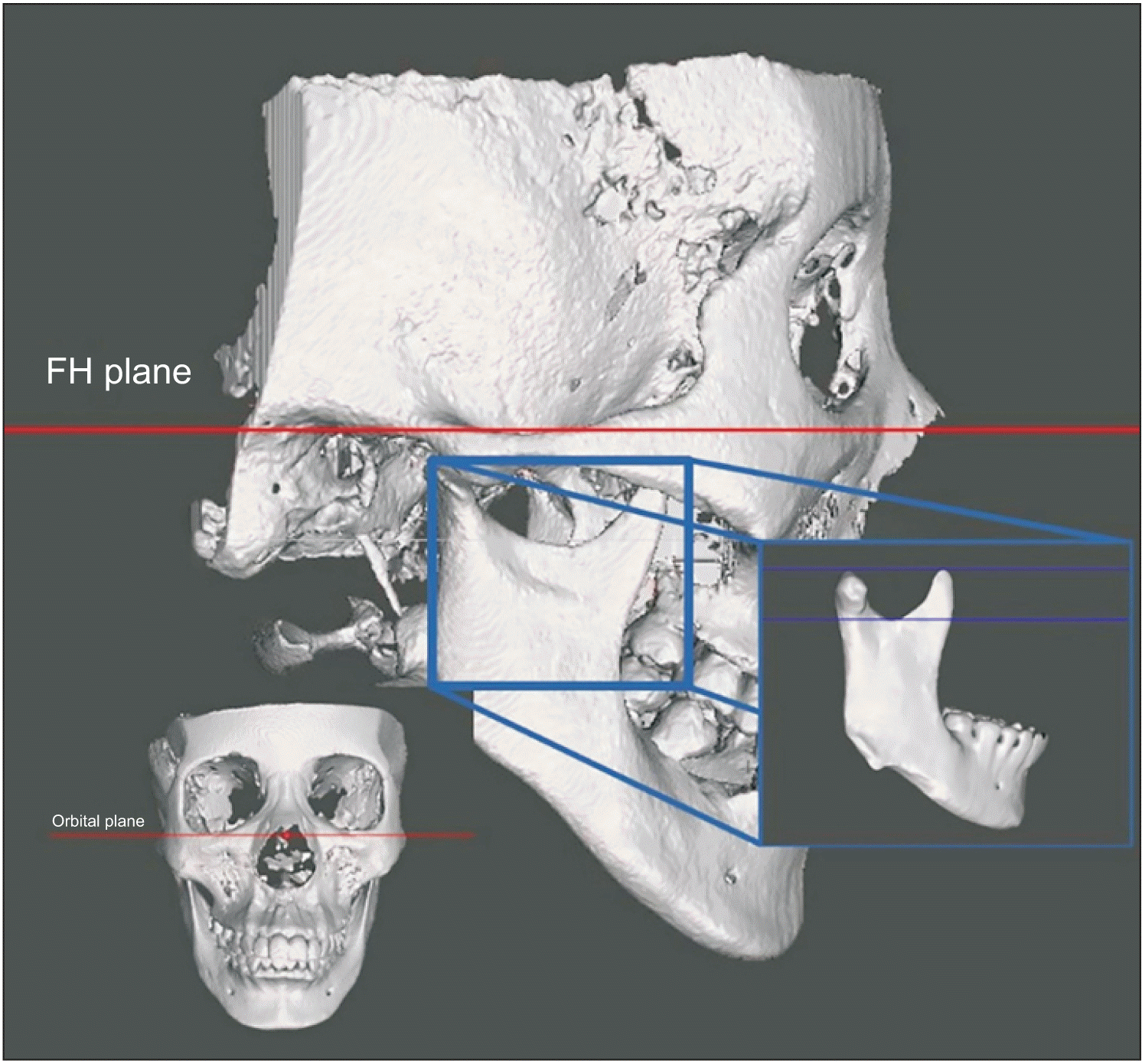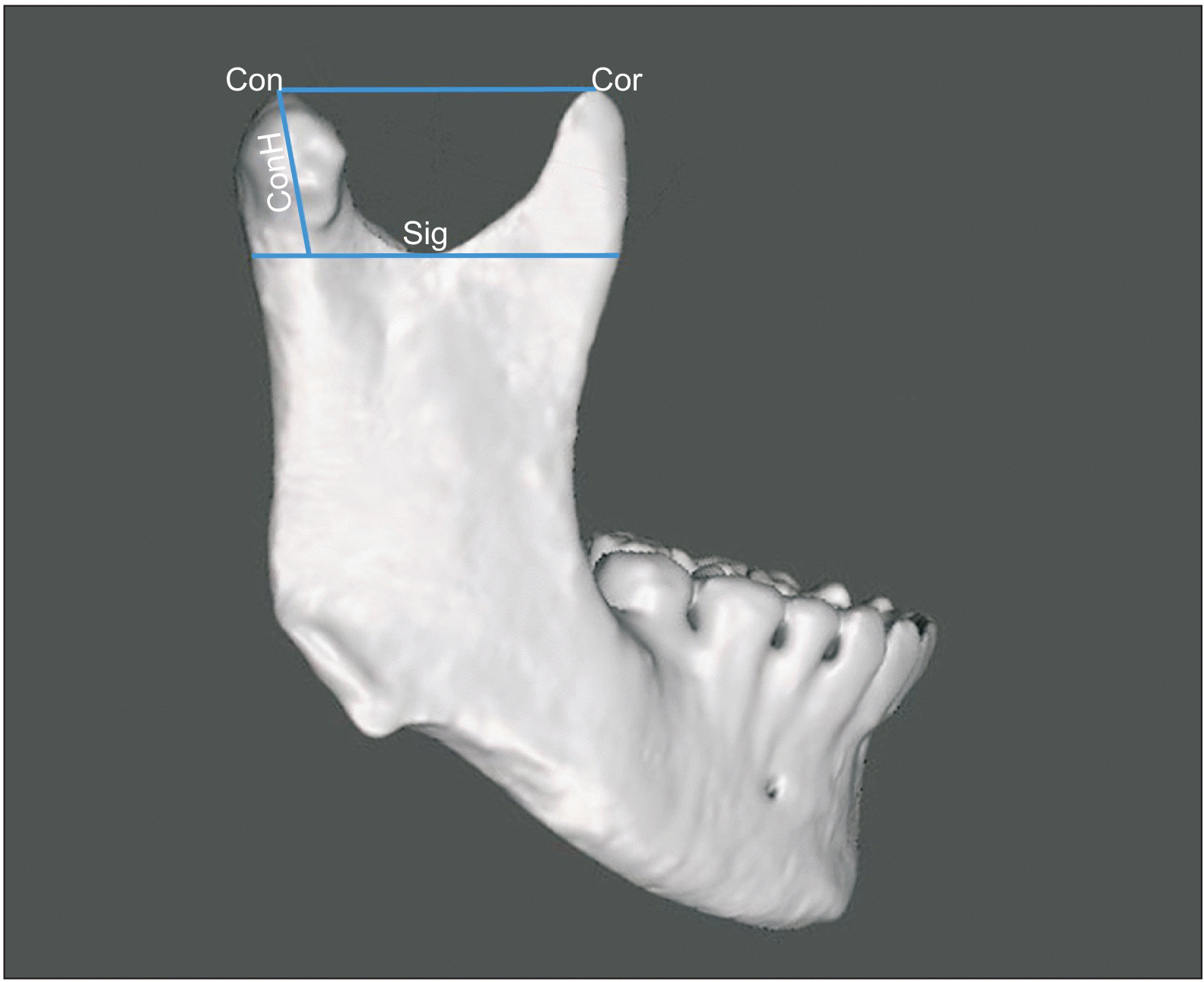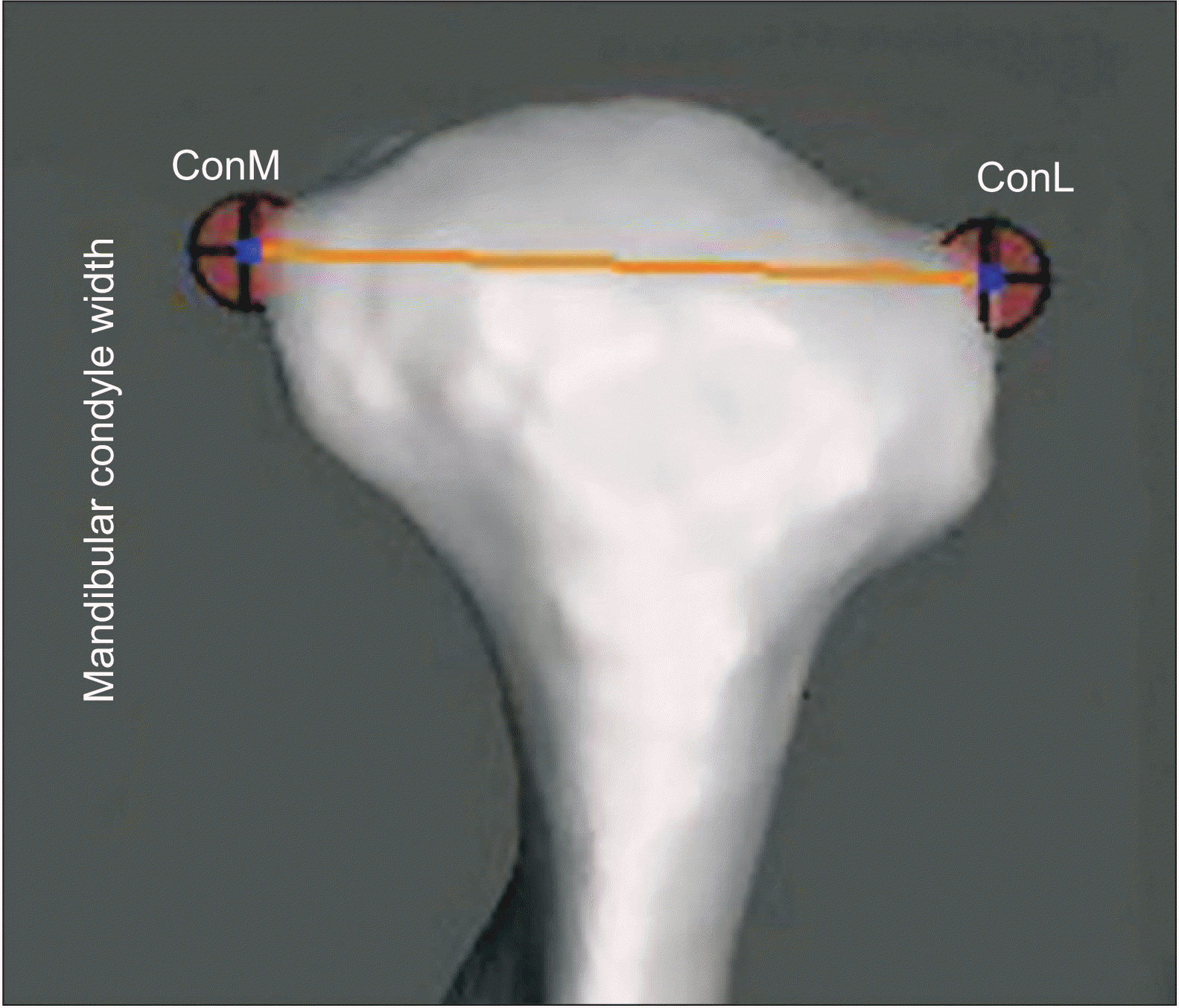INTRODUCTION
MATERIALS AND METHODS
Sample-size calculation
Participants
Table 1
Study design
 | Figure 1Three-dimensional model orientation: the Frankfort horizontal (FH) and orbital planes parallel to the floor and the sigmoid plane in the box parallel to the Frankfort plane. |
 | Figure 2Sagittal view showing the landmarks used for measurements of the mandibular condyle.
Con, the most superior point of the mandibular condyle; Cor, the most superior point of the coronoid process; ConH, a line extending from Con to the sigmoid plane, intersecting the long axis of the mandibular condyle; Sig, sigmoid notch.
|
Statistical analysis
Table 2
Table 3
| Variable | Sex | Mean | SD | T-value | p-value |
|---|---|---|---|---|---|
| LCW | M | 19.40 | 2.42 | 1.73 | 0.08 |
| F | 18.64 | 2.55 | |||
| LCH | M | 19.08 | 3.38 | 0.67 | 0.50 |
| F | 18.69 | 3.23 | |||
| RCW | M | 19.14 | 2.44 | 0.79 | 0.42 |
| F | 18.80 | 2.39 | |||
| RCH | M | 18.97 | 3.01 | 0.27 | 0.78 |
| F | 18.82 | 3.14 |
Table 4
| Variables | ANB groups | Mean | SD | p-value† | Mean difference | p-value‡ | ||
|---|---|---|---|---|---|---|---|---|
| LCW | Class I | 18.85 | 2.36 | 0.454 | Class I | Class II | 0.18 | 0.942 |
| Class II | 18.66 | 2.71 | Class III | –0.46 | 0.683 | |||
| Class III | 19.32 | 2.48 | Class II | Class I | –0.18 | 0.942 | ||
| Class III | –0.65 | 0.476 | ||||||
| LCH | Class I | 18.49 | 3.17 | 0.000*** | Class I | Class II | 0.84 | 0.438 |
| Class II | 17.65 | 3.07 | Class III | –1.92 | 0.015 | |||
| Class III | 20.41 | 3.05 | Class II | Class I | –0.84 | 0.438 | ||
| Class III | –2.76 | 0.000*** | ||||||
| RCW | Class I | 18.84 | 2.20 | 0.510 | Class I | Class II | 0.14 | 0.963 |
| Class II | 18.70 | 2.64 | Class III | –0.42 | 0.703 | |||
| Class III | 19.27 | 2.38 | Class II | Class I | –0.14 | 0.963 | ||
| Class III | –0.56 | 0.538 | ||||||
| RCH | ClassI | 18.74 | 2.72 | 0.000*** | Class I | Class II | 1.15 | 0.168 |
| Class II | 17.58 | 3.11 | Class III | –1.58 | 0.037 | |||
| Class III | 20.32 | 2.81 | Class II | Class I | –1.15 | 0.168 | ||
| Class III | –2.74 | 0.000*** | ||||||
Table 5
| Variables | SN-MP groups | Mean | SD | p-value† | Mean difference | p-value‡ | ||
|---|---|---|---|---|---|---|---|---|
| LCW | Hypodivergent | 19.25 | 2.03 | 0.553 | Hypodivergent | Normodivergent | 0.28 | 0.861 |
| Normodivergent | 18.96 | 2.51 | Hyperdivergent | 0.66 | 0.555 | |||
| Hyperdivergent | 18.59 | 2.98 | Normodivergent | Hypodivergent | –0.28 | 0.861 | ||
| Hyperdivergent | 0.37 | 0.784 | ||||||
| LCH | Hypodivergent | 18.87 | 3.23 | 0.986 | Hypodivergent | Normodivergent | 0.06 | 0.995 |
| Normodivergent | 18.80 | 3.29 | Hyperdivergent | –0.04 | 0.998 | |||
| Hyperdivergent | 18.92 | 3.44 | Normodivergent | Hypodivergent | –0.06 | 0.995 | ||
| Hyperdivergent | –0.11 | 0.987 | ||||||
| RCW | Hypodivergent | 19.31 | 2.01 | 0.276 | Hypodivergent | Normodivergent | 0.30 | 0.837 |
| Normodivergent | 19.01 | 2.45 | Hyperdivergent | 0.91 | 0.295 | |||
| Hyperdivergent | 18.40 | 2.67 | Normodivergent | Hypodivergent | –0.30 | 0.837 | ||
| Hyperdivergent | 0.60 | 0.489 | ||||||
| RCH | Hypodivergent | 18.87 | 2.88 | 0.999 | Hypodivergent | Normodivergent | –0.01 | 1.000 |
| Normodivergent | 18.89 | 2.90 | Hyperdivergent | –0.01 | 1.000 | |||
| Hyperdivergent | 18.88 | 3.65 | Normodivergent | Hypodivergent | 0.01 | 1.000 | ||
| Hyperdivergent | 0.00 | 1.000 | ||||||
Table 6
| Variables | SN-MP groups | Mean | SD | p-value† | Mean difference | p-value‡ | ||
|---|---|---|---|---|---|---|---|---|
| LCW | Group 1 ≤ 20 yr | 18.31 | 2.28 | 0.233 | Group 1 ≤ 20 yr | 21 yr ≤ Group 2 < 30 yr | –0.88 | 0.238 |
| 21 yr ≤ Group 2 < 30 yr | 19.2 | 2.38 | Group 3 ≥ 30 yr | –0.72 | 0.550 | |||
| Group 3 ≥ 30 yr | 19.04 | 3.13 | 21 yr ≤ Group 2 < 30 yr | Group 1 ≤ 20 yr | 0.88 | 0.238 | ||
| Group 3 ≥ 30 yr | 0.15 | 0.963 | ||||||
| LCH | Group 1 ≤ 20 yr | 18.57 | 3 | 0.844 | Group 1 ≤ 20 yr | 21 yr ≤ Group 2 < 30 yr | –0.39 | 0.844 |
| 21 yr ≤ Group 2 < 30 yr | 18.97 | 3.21 | Group 3 ≥ 30 yr | –0.3 | 0.942 | |||
| Group 3 ≥ 30 yr | 18.87 | 3.95 | 21 yr ≤ Group 2 < 30 yr | Group 1 ≤ 20 yr | 0.39 | 0.844 | ||
| Group 3 ≥ 30 yr | 0.09 | 0.991 | ||||||
| RCW | Group 1 ≤ 20 yr | 18.14 | 2.07 | 0.084 | Group 1 ≤ 20 yr | 21 yr ≤ Group 2 < 30 yr | –1.06 | 0.099 |
| 21 yr ≤ Group 2 < 30 yr | 19.21 | 2.32 | Group 3 ≥ 30 yr | –1.04 | 0.257 | |||
| Group 3 ≥ 30 yr | 19.18 | 2.9 | 21 yr ≤ Group 2 < 30 yr | Group 1 ≤ 20 yr | 1.06 | 0.099 | ||
| Group 3 ≥ 30 yr | 0.02 | 0.990 | ||||||
| RCH | Group 1 ≤ 20 yr | 18.44 | 3.04 | 0.501 | Group 1 ≤ 20 yr | 21 yr ≤ Group 2 < 30 yr | –0.46 | 0.767 |
| 21 yr ≤ Group 2 < 30 yr | 18.91 | 2.96 | Group 3 ≥ 30 yr | –0.95 | 0.504 | |||
| Group 3 ≥ 30 yr | 19.4 | 3.48 | 21 yr ≤ Group 2 < 30 yr | Group 1 ≤ 20 yr | 0.46 | 0.767 | ||
| Group 3 ≥ 30 yr | –0.49 | 0.789 | ||||||
Table 7
Table 8
Table 9
Table 10
RESULTS
DISCUSSION
CONCLUSIONS
There were no statistical associations between the morphological shapes of the mandibular condyle and sex and sagittal and vertical skeletal malocclusions.
The mandibular condyle height was greater in Class III malocclusion than in Class I and II malocclusions.
The mandibular condyle width of males was greater than that of females.




 PDF
PDF Citation
Citation Print
Print






 XML Download
XML Download